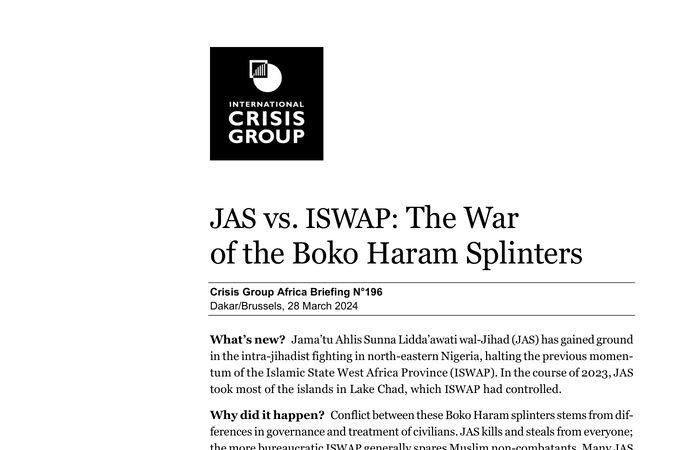The two jihadist groups in north-eastern Nigeria have bruised each other badly in internecine fighting. But they are still a menace to civilians, both in Nigeria and in the other Lake Chad states. The governments cannot afford to shift their gaze from the militant danger.
What’s new?Jama’tu Ahlis Sunna Lidda’awati wal-Jihad (JAS) has gained ground in the intra-jihadist fighting in north-eastern Nigeria, halting the previous momentum of the Islamic State West Africa Province (ISWAP). In the course of 2023, JAS took most of the islands in Lake Chad, which ISWAP had controlled.
Why did it happen?Conflict between these Boko Haram splinters stems from differences in governance and treatment of civilians. JAS kills and steals from everyone; the most bureaucratic ISWAP generally spares Muslim non-combatants. Many JAS members surrendered to authorities or continued fighting instead of joining ISWAP after the death of JAS’s leader in 2021.
Why does it matter?In the last two years, JAS and ISWAP may have visited more damage upon each other than the Lake Chad states have inflicted on the jihadists. Still, the splinters pose a significant threat. ISWAP is regrouping, while the revamped JAS is set to target civilians around the lake.
What should be done?The Lake Chad governments will need to do more to prevail over the jihadists. They should mitigate risks to civilians by maintaining humanitarian assistance; expanding efforts to support defectors; improving airstrike precision; and reinvigorating regional security cooperation.
I. Overview
The balance of power between Boko Haram’s two splinters in north-eastern Nigeria has shifted once more. the death of its leader Abubakar Shekau in 2021, Jama’tu Ahlis Sunna Lidda’awati wal-Jihad (JAS, which is often referred to as Boko Haram) has gone on the offensive, taking most of the Lake Chad islands occupied by its rival, Islamic State West Africa Province (ISWAP), in the last year. ISWAP had held the upper hand in the intra-jihadist war, but has now lost ground, in part because JAS fighters resisted submitting to its rules. The two groups have bruised each other badly, but the Lake Chad states should not think their own battle with the insurgents is won. Together, the militant groups still command thousands of fighters and pose a significant threat. ISWAP is reorganizing in other parts of north-eastern Nigeria, while JAS is preying upon civilians around Lake Chad and from its other stronghold in the Mandara mountains. In addition to stepping up military campaigns, governments should improve services, increase humanitarian assistance to affected communities and invest more in infection programs.
The original Boko Haram emerged in the 2000s, participating in a series of failed urban uprisings in Nigeria’s north east in 2009. Afterward, the group reassembled under Shekau, taking the name JAS. It then evolved from an urban insurgency using terror attacks into a rural guerrilla movement. JAS fighters proceeded to seize control of a substantial part of Borno state and to move into other north-eastern states, as well as the border regions of Nigeria’s neighbors around Lake Chad – Niger, Chad and Cameroon. In 2015, Shekau pledged allegiance to the Islamic State in Iraq and Syria (ISIS), and the movement took the name of ISWAP. It was riven by internal divisions, however, and in 2016 Shekau’s critics broke away, with that secessionist splinter both keeping the ISWAP name and gaining recognition from ISIS. Shekau and his followers organized themselves in a separate faction, reverting to the JAS designation.
After Shekau was defeated in battle by ISWAP and died by his own hand in 2021, ISWAP’s continued rise seemed certain, but since then dynamics have changed. The fighting between JAS and ISWAP has weakened both groups. In early 2022, ISWAP seemed to have the momentum. It even launched its first-ever campaign in central Nigeria, culminating in a major attack on a prison near the federal capital, Abuja. From the end of 2022, however, under a new leader, Bakura Doro, JAS has pushed back hard against ISWAP, chasing it from many Lake Chad islands and seizing supplies. A Lake Chad-based ISWAP sub-group defected to JAS in early 2023. According to former members of both factions, ISWAP and JAS have lost more fighters sparring with each other since 2021 than in confrontations with state militaries. ISWAP is now focusing on consolidating its control in other parts of Borno. For a time, it suspended its attacks in central Nigeria, although an incident in January suggests that these may be starting back up.
The conflict between JAS and ISWAP has to do with a fundamental disagreement over how to treat civilians. Whereas JAS sees all civilians as fair game for plunder, ISWAP treats Muslims differently from non-Muslims. It has tried to improve relations with Muslim civilians, taxing them and providing their version of law and order, rather than simply stealing from them, as JAS does. Upon taking over the area that JAS previously controlled in the Sambisa forest, ISWAP imposed its more bureaucratic model on JAS fighters, banning pillage and seizing weapons. With their livelihoods thus threatened, many JAS fighters refused to join ISWAP. Some chose to surrender to the Nigerian authorities, while others fought back. Now the JAS counterattack has fed tensions within ISWAP, leading to defections. Estimates are that, since 2021, several thousand fighters have quit the two factions combined.
While regional governments may see the conflict between the two jihadist factions as good news, it comes both with risks and with consequences for human security. Both groups still have thousands of fighters and hold swathes of territory. The two have parleyed a number of times and, although it seems unlikely, they might still reach a ceasefire or cooperation deal, taking the conflict in a new direction. But even if they keep fighting each other, and losses remain low for the militaries of the four Lake Chad states, civilians in rural areas are still highly exposed to jihadist violence. With JAS now confidently in control of much of Lake Chad and the Mandara mountains, it will likely intensify its predation, including in Cameroon, Niger and Chad. Its comeback could entice some of the thousands of JAS fighters who have surrendered to take up arms again. As for ISWAP, it will probably keep trying to tighten its grip on central Borno and eastern Yobe state, likely increasing pressure on civilians there. It also still has networks outside north-eastern Nigeria.
Authorities in Nigeria and the other Lake Chad states cannot afford to shift their gaze from the dangers the evolving conflict poses to the population. The Nigerian government says it is time for reconstruction, but this hint at victory being nigh is premature. Given that fighting is likely to persist for some time, regional authorities and outside partners should bolster efforts to blunt the impact on civilians and offer combatants an alternative to conflict. They should expand rather than phase out humanitarian assistance, while also developing better targeting protocols to avoid civilian casualties in air strikes. They should also improve and expand programs for supporting defectors. Finally, regional cooperation with respect to security on the islands and shores of Lake Chad has fallen off in recent years; it is time for an effort to reinvigorate the Multinational Joint Task Force comprising Nigeria and its Lake Chad neighbors.






